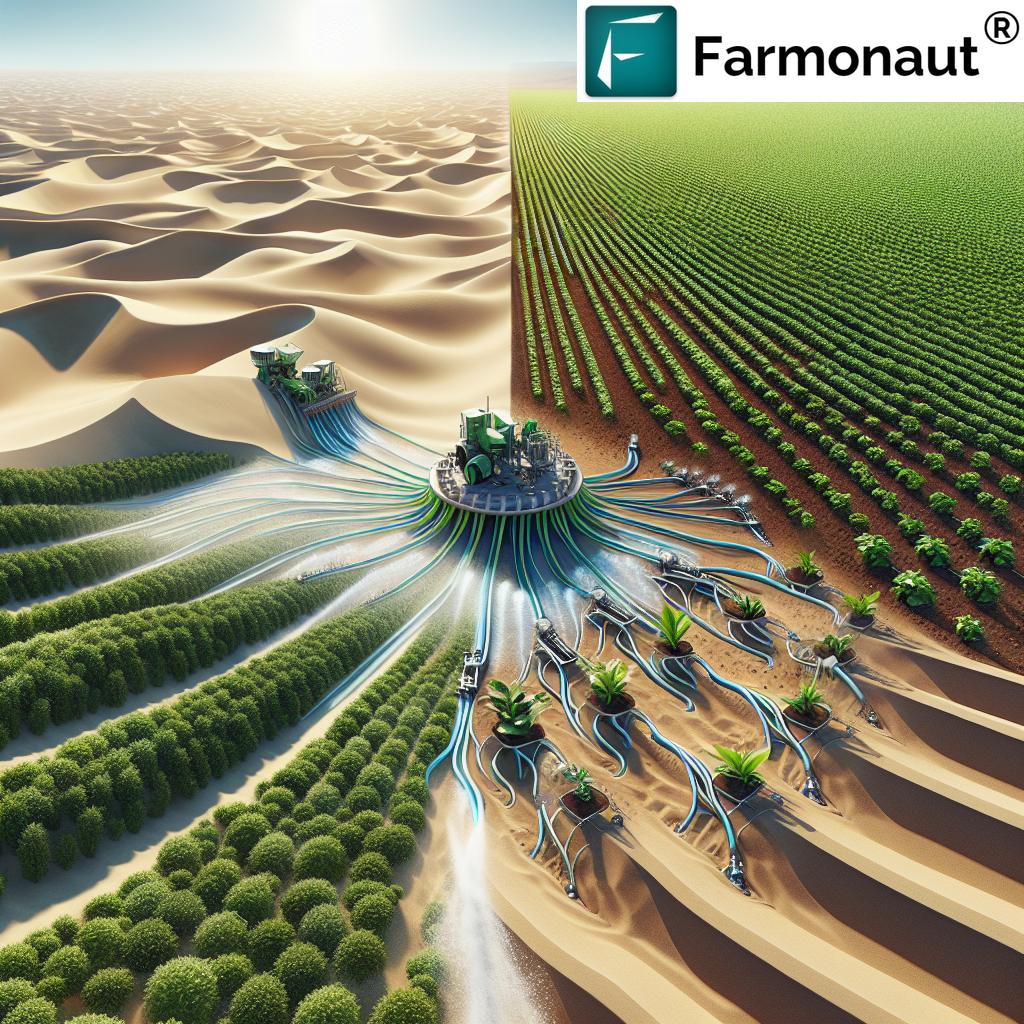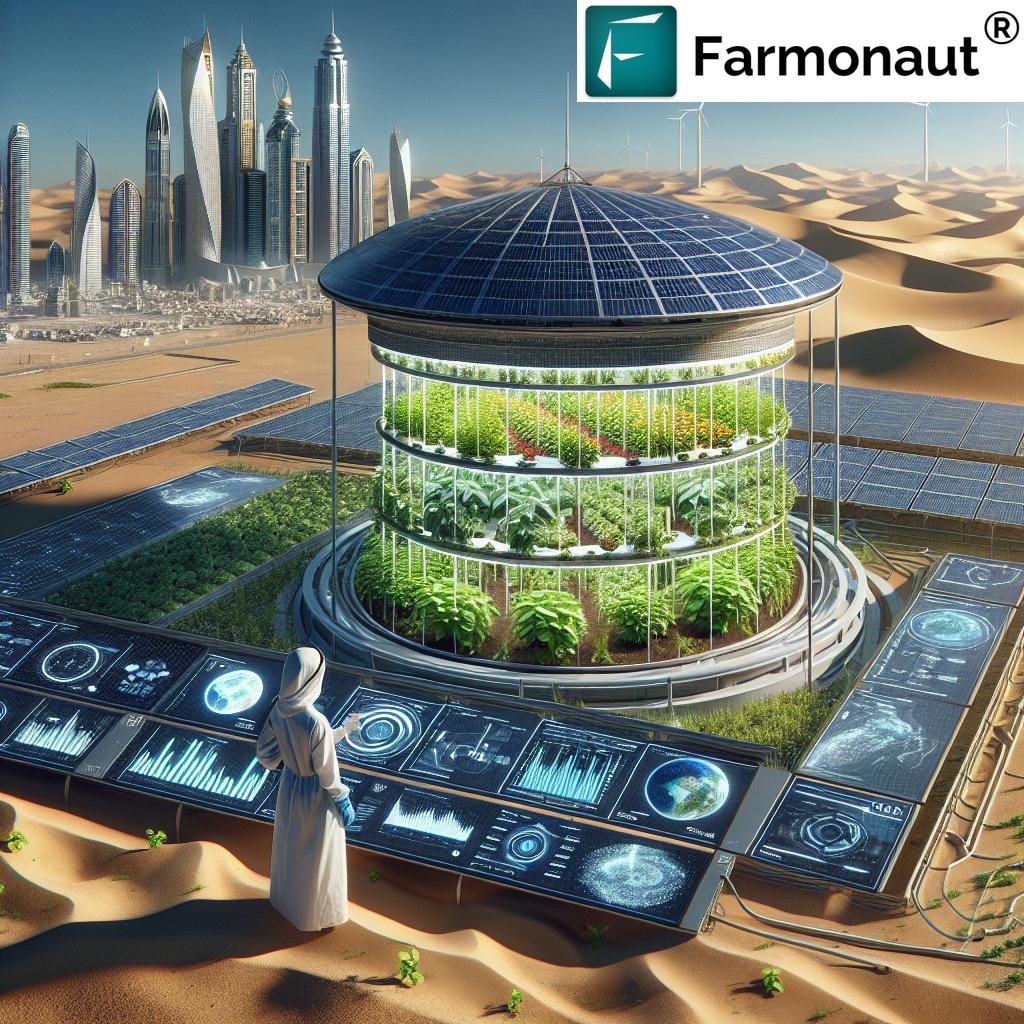Revolutionizing Desert Agriculture: Sustainable Soil Solutions Boost Profitability in UAE and Saudi Arabia
“Liquid Natural Clay technology has transformed soil health in over 1 million square meters of desert land.”
In the challenging landscape of arid regions, we are witnessing a remarkable transformation in agriculture. The deserts of the United Arab Emirates (UAE) and Saudi Arabia are becoming testbeds for innovative technologies that promise to revolutionize farming in water-scarce environments. At the forefront of this revolution is the implementation of sustainable soil solutions and water conservation technology, which are not only enhancing agricultural profitability but also paving the way for climate-resilient farming practices.
The Dawn of Desert Agriculture Innovation
Desert agriculture innovation has taken center stage as countries in the Middle East and beyond seek to address food security concerns and reduce their reliance on imports. We’ve seen a surge in research and development focused on adapting agricultural practices to the unique challenges posed by desert environments. These innovations are not just theoretical; they’re being put into practice with remarkable results.
One of the most promising developments in this field is the emergence of Liquid Natural Clay (LNC) technology. This groundbreaking approach to soil health improvement is transforming barren desert lands into fertile grounds capable of supporting diverse crops. By enhancing the soil’s water retention capabilities and improving its structure, LNC technology is proving to be a game-changer in combating desertification and boosting agricultural yields in arid regions.
Water Conservation: The Lifeblood of Desert Agriculture
In desert regions, water is the most precious resource, and its conservation is paramount to the success of any agricultural venture. We’re seeing significant advancements in water conservation technology that are making it possible to grow crops with minimal water usage. These technologies include:
- Precision irrigation systems
- Soil moisture sensors
- Drought-resistant crop varieties
- Water recycling and treatment facilities
These innovations are not only reducing water consumption but also improving crop quality and yield. For instance, the implementation of drip irrigation systems in conjunction with LNC technology has shown water savings of up to 50% while maintaining or even increasing crop productivity.

Climate-Resilient Farming: Adapting to Harsh Realities
As global temperatures rise and weather patterns become increasingly unpredictable, the need for climate-resilient farming practices has never been more urgent. In the UAE and Saudi Arabia, we’re witnessing the development of next-generation crop production systems designed to withstand extreme temperatures and prolonged periods of drought.
These systems often incorporate:
- Heat-resistant greenhouse technologies
- Vertical farming techniques
- AI-driven climate control systems
- Genetic modifications for heat and salt tolerance in crops
By implementing these advanced techniques, farmers in arid regions are not only able to grow a wider variety of crops but also extend growing seasons and increase overall production.
Sustainable Golf Course Management: Green Oases in the Desert
It’s not just traditional agriculture that’s benefiting from these innovations. Sustainable golf course management has become a significant focus in regions like the UAE, where luxury tourism plays a crucial role in the economy. Golf courses are notorious for their high water consumption, but new approaches are changing the game.
We’re seeing the adoption of:
- Drought-tolerant grass varieties
- Smart irrigation systems
- Greywater recycling
- LNC technology for improved soil health
These methods are allowing golf courses to maintain their lush appearance while dramatically reducing their environmental impact and operational costs.
The Economic Impact: Boosting Agricultural Profitability
The implementation of these sustainable soil solutions and innovative farming practices is having a profound impact on agricultural profitability in arid regions. We’re observing:
- Increased crop yields
- Reduced input costs (particularly water and fertilizers)
- Extended growing seasons
- Diversification of crop types
- Enhanced product quality commanding premium prices
These factors combined are contributing to a significant boost in profitability for farmers and agribusinesses operating in the UAE and Saudi Arabia.
“Sustainable soil solutions have increased agricultural profitability by 30% in UAE and Saudi Arabia’s arid regions.”
Case Study: Desert Control’s Breakthrough Year
A prime example of the progress being made in desert agriculture is the recent success of Desert Control AS (DSRT), a Norwegian company specializing in sustainable soil and water solutions. The company reported significant advancements and impressive financial results for the fiscal year ending December 31, 2024.
Key highlights include:
- Securing full-scale commercial projects for golf courses in California
- Tripling of licensing revenue and deployment activity in the Middle East
- International recognition from the United Nations World Food Programme (WFP)
- A remarkable increase in revenue, with LNC revenues surpassing NOK 1.88 million in 2024
- Improved EBITDA, demonstrating operational efficiencies
These achievements underscore the growing demand for innovative solutions in desert agriculture and the potential for significant market growth in this sector.

The Role of Technology in Modern Desert Farming
As we delve deeper into the world of desert agriculture, it’s crucial to recognize the pivotal role that technology plays in making these advancements possible. From satellite imagery to artificial intelligence, modern tools are empowering farmers to make data-driven decisions and optimize their operations like never before.
One such technological innovation comes from Farmonaut, a pioneering agricultural technology company that offers advanced, satellite-based farm management solutions. Through its web application and mobile apps for Android and iOS, Farmonaut provides farmers with real-time insights into crop health, soil moisture levels, and other critical metrics.
These tools enable farmers to:
- Monitor crop health remotely
- Optimize irrigation schedules
- Detect pest and disease outbreaks early
- Plan resource allocation more effectively
For developers and businesses looking to integrate these capabilities into their own systems, Farmonaut also offers an API with comprehensive documentation.
The Future of Desert Agriculture: Ambitious Plans and Innovations
Looking ahead, the future of desert agriculture is bright with ambitious plans and continuous innovations. We anticipate seeing:
- Expansion of LNC technology to larger agricultural areas
- Integration of AI and machine learning for predictive farming
- Development of more resilient crop varieties through genetic research
- Implementation of blockchain for improved supply chain transparency
- Increased use of renewable energy in farming operations
These advancements are not just improving agricultural outputs; they’re also contributing to broader goals of food security, ecosystem resilience, and sustainable development in water-scarce regions.
Comparative Analysis of Desert Agriculture Solutions
| Technology/Solution | Primary Application | Key Benefits | Estimated Water Savings (%) | Potential Yield Increase (%) | Regions of Implementation | Adoption Stage |
|---|---|---|---|---|---|---|
| Liquid Natural Clay (LNC) | Soil Health | Improved water retention, soil structure | 50-60 | 30-40 | UAE, Saudi Arabia, California | Early Commercial |
| Precision Irrigation Systems | Water Conservation | Targeted water application, reduced waste | 30-50 | 20-30 | UAE, Saudi Arabia, Global | Widespread |
| Climate-Resilient Greenhouses | Crop Production | Year-round growing, climate control | 70-80 | 50-100 | UAE, Saudi Arabia | Expanding |
| Drought-Tolerant Golf Course Management | Landscaping | Reduced water use, lower maintenance | 40-60 | N/A | UAE, California | Pilot to Early Adoption |
| Satellite-Based Farm Management (e.g., Farmonaut) | Precision Agriculture | Data-driven decisions, resource optimization | 20-40 | 15-25 | Global | Growing Adoption |
Enhancing Food Security Through Innovation
One of the most significant impacts of these desert agriculture innovations is on food security. Countries in arid regions have long been dependent on imports for a substantial portion of their food supply. However, with the advancements we’re seeing in sustainable soil solutions and water conservation technology, there’s a growing potential for these nations to increase their self-sufficiency in food production.
Key areas of impact include:
- Increased local production of staple crops
- Year-round availability of fresh produce
- Reduced vulnerability to global supply chain disruptions
- Creation of jobs in the agricultural sector
- Potential for export of high-value crops grown in controlled environments
By leveraging technologies like those offered by Farmonaut, farmers and policymakers can make more informed decisions about crop selection, resource allocation, and long-term agricultural planning, all of which contribute to enhanced food security.
Ecosystem Resilience and Biodiversity
While the primary focus of desert agriculture innovation is often on crop production and water conservation, these advancements are also having a positive impact on ecosystem resilience and biodiversity. By improving soil health and reducing the need for harmful pesticides and fertilizers, sustainable farming practices are creating more hospitable environments for local flora and fauna.
Some notable benefits include:
- Increased soil organic matter, supporting microbial life
- Creation of green corridors in desert landscapes
- Reduced chemical runoff into natural water systems
- Potential for reintroduction of native plant species
- Improved habitats for pollinators and other beneficial insects
These ecological improvements not only benefit the environment but also contribute to the long-term sustainability of agricultural practices in these regions.
Operational Efficiency and Resource Management
The integration of advanced technologies in desert agriculture is dramatically improving operational efficiency and resource management. Farmers and agribusinesses are now able to do more with less, optimizing their use of water, energy, and labor.
Key improvements in operational efficiency include:
- Automated irrigation systems that respond to real-time soil moisture data
- Predictive maintenance of farming equipment to reduce downtime
- Optimized harvesting schedules based on crop maturity data
- Efficient use of fertilizers and pesticides through precision application
- Reduced energy consumption through smart climate control in greenhouses
These efficiencies not only reduce costs but also minimize the environmental impact of agricultural activities, aligning with global sustainability goals.
The Role of Government and Private Sector Collaboration
The rapid advancement of desert agriculture in the UAE and Saudi Arabia is largely due to strong collaboration between government entities and the private sector. We’re seeing a concerted effort to create an ecosystem that fosters innovation and supports the adoption of new technologies.
Key initiatives include:
- Government-funded research programs focused on desert agriculture
- Tax incentives for companies developing sustainable farming solutions
- Public-private partnerships for large-scale agricultural projects
- Educational programs to train the next generation of agricultural technologists
- International collaborations to share knowledge and best practices
This collaborative approach is accelerating the pace of innovation and ensuring that advancements in desert agriculture quickly translate into real-world applications.
Challenges and Future Considerations
While the progress in desert agriculture is impressive, it’s important to acknowledge the challenges that remain and consider future implications. Some key areas of concern include:
- Long-term environmental impacts of intensive desert farming
- Potential overreliance on technology and the need for robust backup systems
- Ensuring equitable access to advanced agricultural technologies
- Balancing water use between agriculture and other sectors in water-scarce regions
- Adapting to increasingly extreme weather events due to climate change
Addressing these challenges will be crucial for the continued success and sustainability of desert agriculture initiatives.
Conclusion: A Green Revolution in the Desert
The advancements we’re witnessing in desert agriculture represent nothing short of a green revolution in some of the world’s most challenging environments. Through the implementation of sustainable soil solutions, water conservation technology, and climate-resilient farming practices, countries like the UAE and Saudi Arabia are transforming their agricultural landscapes.
The success of companies like Desert Control and the growing adoption of technologies offered by firms such as Farmonaut underscore the immense potential of these innovations. As we look to the future, it’s clear that desert agriculture will play a crucial role in addressing global food security challenges, promoting sustainable development, and creating new economic opportunities in arid regions.
The journey toward fully sustainable and productive desert agriculture is ongoing, but the progress made thus far is both inspiring and promising. By continuing to invest in research, fostering innovation, and promoting collaboration between governments, private sector entities, and farmers, we can ensure that the deserts of today become the thriving agricultural hubs of tomorrow.
FAQ Section
Q: What is Liquid Natural Clay (LNC) technology, and how does it benefit desert agriculture?
A: Liquid Natural Clay technology is an innovative soil treatment that improves water retention and soil structure in arid environments. It helps combat desertification, reduces water usage, and increases crop yields by creating a more favorable growing environment in desert soils.
Q: How are sustainable soil solutions improving profitability in UAE and Saudi Arabian agriculture?
A: Sustainable soil solutions are boosting profitability by reducing water and fertilizer costs, increasing crop yields, and enabling the cultivation of a wider variety of crops. These improvements lead to higher revenues and lower operational costs for farmers and agribusinesses.
Q: What role does technology play in modern desert farming?
A: Technology plays a crucial role in desert farming through satellite-based monitoring, AI-driven decision-making systems, precision irrigation, and advanced greenhouse technologies. These tools help farmers optimize resource use, predict crop health issues, and maximize yields in challenging environments.
Q: How are golf courses in arid regions becoming more sustainable?
A: Golf courses in arid regions are adopting drought-tolerant grass varieties, implementing smart irrigation systems, recycling greywater, and using technologies like LNC to improve soil health. These methods significantly reduce water consumption while maintaining the quality of the courses.
Q: What are the main challenges facing the future of desert agriculture?
A: Key challenges include managing long-term environmental impacts, ensuring equitable access to advanced technologies, balancing water use across sectors, and adapting to extreme weather events due to climate change. Addressing these issues is crucial for the sustained success of desert agriculture initiatives.
Earn With Farmonaut: Affiliate Program
Earn 20% recurring commission with Farmonaut’s affiliate program by sharing your promo code and helping farmers save 10%. Onboard 10 Elite farmers monthly to earn a minimum of $148,000 annually—start now and grow your income!
As we conclude this exploration of revolutionary desert agriculture practices, it’s clear that the future of farming in arid regions is bright. The innovations and technologies we’ve discussed are not just theoretical concepts but are being actively implemented and refined in the fields of the UAE, Saudi Arabia, and beyond. By embracing these sustainable soil solutions and water conservation technologies, we’re not only boosting agricultural profitability but also paving the way for a more food-secure and environmentally resilient future.
We encourage farmers, agribusinesses, and policymakers to continue exploring and adopting these groundbreaking approaches to desert agriculture. The potential for growth, sustainability, and positive impact on both local economies and global food systems is immense. As we move forward, let’s keep pushing the boundaries of what’s possible in agriculture, turning the challenges of desert environments into opportunities for innovation and prosperity.




